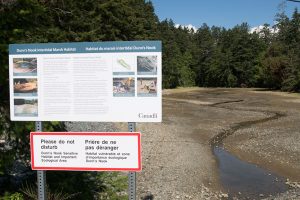Dunn’s Nook fish habitat compensation project launched
By Lookout on Jul 29, 2016 with Comments 0

Image of Dunn’s Nook Fish Habitat project, taken at F Jetty, CFB Esquimalt. Photo by LS Ogle Henry, MARPAC Imaging Services
Lorraine Crinkley, FSE ~
Public Works Government Services Canada (PWGSC) and Formation Safety and Environment (FSE) were onsite July 18 at Colwood for the unveiling of the Dunn’s Nook Fish Habitat Compensation Project.
The project created intertidal marsh habitat at Dunn’s Nook located adjacent to F jetty in Colwood.
As part of the PWGSC’s Esquimalt Graving Dock Waterlot Remediation Project, the Dunn’s Nook habitat was created to offset impacts caused by project activities.
As part of the agreement, PWGSC cleaned up a contaminated site within Dunn’s Nook, improved the local habitat, and will transfer any surplus habitat credits to DND for application on future marine capital projects. Dunn’s Nook had been impacted by human activity since the mid 1900s when Wilfert Road and the culverts beneath it were constructed. This original development restricted tidal flow and passage of fish and other marine life into the marsh, and caused standing water to remain during low tide events. This resulted in anoxic, low quality fish habitat that had the potential for stranding and killing fish.
Intertidal marsh area in Esquimalt harbour is a rare feature, and successful re-establishment of this habitat would be a substantial contribution to local biodiversity. Salt marshes are one of the most productive ecosystems on earth; they act as nurseries for plant and animal species, provide food and habitat for birds and other wildlife, slow shoreline erosion, absorb excess nutrients, and help to protect coastal areas from flooding.
The Dunn’s Nook Fish Habitat Compensation Project began with the completion of several site assessments including a tidal flow assessment, chemical analysis of soils, and archaeological assessment to ensure the protection of nearby archaeological site DcRu-137.
Once the assessments were completed, 930m3 of sediment contaminated with PCBs, PAHs and metals were removed from the site. New material was then brought in to re-profile Dunn’s Nook creating benches, dendritic channels intertidal flats and salt tolerant plants, all of which are naturally occurring features of a healthy intertidal marsh.
Post restoration, a monitoring plan has been established for the site that includes assessments of the success of the colonization of marsh vegetation, fish usage and the physical stability of the constructed habitat. Salt marshes are slow growing, dynamic, sensitive ecosystems which require as little human interaction as possible.
Vegetation can be easily trampled and birds and their nesting sites can also be disturbed by visitors.
Signage has been put up around the site to not disturb the area due to the sensitivity of the habitat.
If you are over in Colwood take a few moments to view the new signage that describes details of the project and restored habitat.
Filed Under: Top Stories
About the Author:





